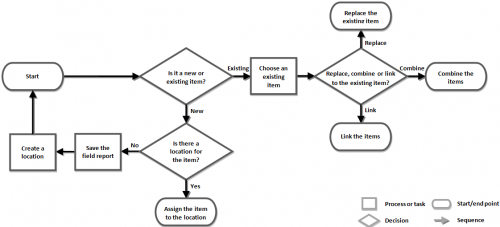Difference between revisions of "Documenting Customisations"
| Line 78: | Line 78: | ||
<li>Completion reports</li> | <li>Completion reports</li> | ||
</ol> | </ol> | ||
| − | <li> | + | <li>Education activities</li> |
<li>Quality management</li> | <li>Quality management</li> | ||
<ol type="i"> | <ol type="i"> | ||
Revision as of 20:04, 22 April 2013
Document Workflows and Business Rules
After the desired data elements and field report templates are customised and published, the next step is to define and document the information workflow for each type of field report. This is a critical step for ensuring the quality of the data stored in IMSMANG. It involves combining the workflow rules identified in Chapter 1 with the field report templates defined in Chapter 2 to create a set of workflows that can be documented as instructions or SOPs for entering and reconciling data in IMSMANG. Each workflow and SOP should include rules for:
- assigning locations
- updating and replacing items
- linking items
With these rules defined, information managers can help improve data consistency and ease of searching and reporting while reducing data entry errors and the effort to correct them later. Information managers can also develop data quality searches and reports that identify and enforce the information workflows. The diagram below identifies a basic information workflow, but information managers should provide guidance to data entry personnel for how the workflow should proceed in their programmes.
Example of a Basic Information Workflow
Creating a Programme Specific User Guide
Creating a programme-specific user guide is a critical step in communicating information management concepts and decisions to IMSMANG users, particularly because IMSMANG is so customisable. With a programme-specific user guide information managers can:
- ensure faster training of information management and operations staff
- reduce the likelihood and impact of data quality problems
- provide an easy reference for data entry personnel and users of IMSMANG information
The following sections provide guidance on creating a programme-specific user guide that supplements the IMSMANG User Guide with specialised steps for how information should be managed within the programme.
| How To |
|---|
Content to Include
The guide should document the programme-specific customisations of IMSMANG as discussed in Chapter 1 and Chapter 2 of this manual. It should provide straightforward, task-specific guidance and avoid complicated discussions of possible options and conditions. Ideally, the guide is an intermediate document that bridges the gap between the goals, objectives and terms of reference of information management and the specific “how-to” instructions in the IMSMANG User Guide.
Overview
The Overview section should cover basic information about the guide, its purpose and intent and about information management responsibilities. It should describe the overall workings of IMSMANG including the configuration of the IMSMANG system within the programme as well as the number of users and basic roles and responsibilities.
Items and Processes
In this section, information managers should define each item and process that will be tracked in IMSMANG. Following the recommendations in XXX, this information should include:
- description of each item category and subcategory that will be used (see Items)
- definition of what each item category and subcategory will be used for (see Items)
- list of key data elements including custom-defined fields (see Items)
- description of the relationships among items (see Assigning and Linking)
- list of the status values for each item (see Status Changes)
- direction for how locations will be used (see Location)
- description for how tasking will be used (see Tasking Tool)
Workflow and Business Rules
This section should define the workflows and business rules that are to be followed when collecting and updating hazard and hazard reduction information. Workflows identify the processes (hazard reductions) undertaken on a hazard and the resulting status changes, from identification to clearance and completion. Include a workflow for each different kind of hazard in use
Data Entry Process and Guidelines
When the relevant items, processes and workflows are identified and documented, information managers should provide guidelines to assist data entry personnel in correctly entering, reconciling and linking data according to the processes. The guidelines should include an entry for each of the field report templates to be used and a description for how each should be entered. At a minimum, these guidelines should include:
- name and description for each field report template
- list of required fields and what the values should be
- definition of how the items in the field report should be reconciled (as new or as updates)
- description of how to determine the location for each item in the form if it is new
- definition of which existing items should be linked to the items in the field report
Outline to Follow
Below is an outline of a programme-specific user guide with suggestions for content to include in each section.
- Overview
- Items and Processes
- Locations
- Hazards
- Suspected hazardous areas (SHA)
- Confirmed hazardous areas (CHA)
- Minefields
- UXO spots
- Hazard reductions
- Technical surveys
- Clearances
- Progress reports
- Completion reports
- Education activities
- Quality management
- Quality assurance reports
- Quality management reports
- Accidents and victims
- Demining accidents
- Mine accidents
- Civilian victims
- Demining victims
- Auxiliary data
- Places
- Organisations
- Ordnance
- Workflow and business rules
- CHA/minefield clearance workflow
- Spot UXO clearance workflow
- Data entry guide
- Entering a new minefield form
- Entering a minefield update form
- Entering a hazard status change form
- Entering a new clearance form
- Entering progress reports
